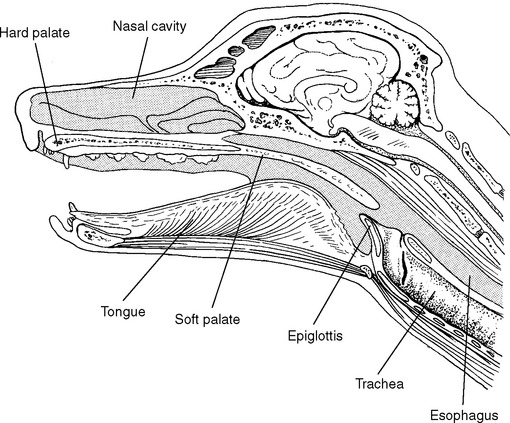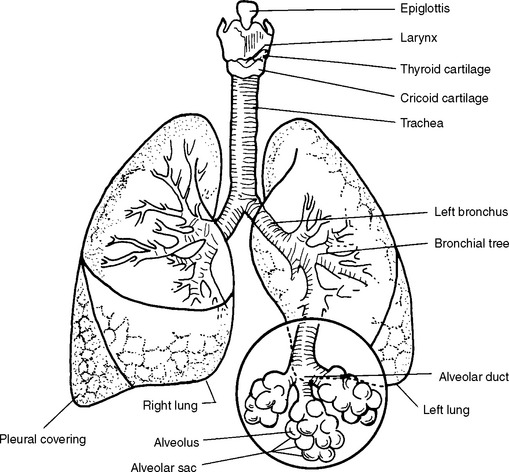Chapter 11 Diseases of the Respiratory System
All of the cells within an animal’s body require oxygen for metabolism. When glucose is burned (in the cell) with oxygen, the by-products are energy, water, and carbon dioxide. Carbon dioxide, a waste product, must be eliminated from the body, whereas water and energy are used to maintain all the life processes. The respiratory system transports oxygen to the bloodstream and removes carbon dioxide. Malfunction of this system affects all functions in the living animal.
We can arbitrarily divide the respiratory system into the upper respiratory tract (nasal cavity, sinuses, nasopharynx, and larynx; Fig. 11-1) and the lower respiratory tract (trachea, bronchi, lungs, and pleural cavity; Fig. 11-2). The technology student is referred to an anatomy text for review of the anatomy and physiology of the respiratory system.

Figure 11-1 Cross section of the upper respiratory tract of the dog.
(From McBride DF: Learning veterinary terminology, ed 2, St Louis, 2002, Mosby, by permission.)

Figure 11-2 Lower respiratory tract, including an alveolus.
(From McBride DF: Learning veterinary terminology, ed 2, St Louis, 2002, Mosby, by permission.)
DISEASES OF THE UPPER RESPIRATORY TRACT
DISEASES OF THE LOWER RESPIRATORY TRACT
Diseases that involve the lower respiratory tract are of more serious clinical significance than those of the upper airways (see Color Plate 10). Examples of lower airway diseases include tracheobronchitis, tracheal collapse, feline asthma, feline viral respiratory infections, pneumonia, heartworm disease (feline), neoplasia, pulmonary edema, and hemothorax/pneumothorax.
Infectious Canine Tracheobronchitis (Kennel Cough)
TREATMENT
Feline Bordetella Infection
Collapsing Trachea
DIAGNOSIS
TREATMENT
Symptomatic treatment
Feline Asthma
TREATMENT
INFORMATION FOR CLIENTS
Feline Heartworm Disease
Heartworm infection in cats is less common than in dogs (about 5%-20% of canine prevalence). Clinical symptoms of the disease in cats, however, are often more severe than in the dog, although the worm burden is usually small (Table 11-1). This disease is seen in 38 of the 50 states, mostly along coastal areas and the Mississippi River Valley.
Table 11-1 Feline Heartworm Disease versus Canine Heartworm Disease
| Dog | Cat | |
|---|---|---|
| Biology of Dilofilaria immitis | ||
| Microfilaremia | 30%-80% of infected dogs | Rare, transient |
| Number of adult worms | >50 common | 1-3 common |
| Ectopic migration | Rare | More common |
| Adult lifespan | Approximately 5 yr | Approximately 2 yr |
| Clinical signs of heartworm disease | ||
| No signs | Most common | Most common |
| Respiratory signs | Common | Common |
| Vomiting | Unusual | Fairly common |
| Exercise intolerance | Common | Rare |
| Ascites | Common | Rare |
| Sudden death | Rare | More common |
| Radiographic findings | ||
| Enlarged pulmonary arteries | Characteristic | Characteristic |
| Blunting/tortuosity | Common | Occasional |
| Infiltrates in lung | Possible | Possible |
| Right-sided heart enlargement | Occasional | Rare |
| Pulmonary artery “knob” | Characteristic | Not seen |



